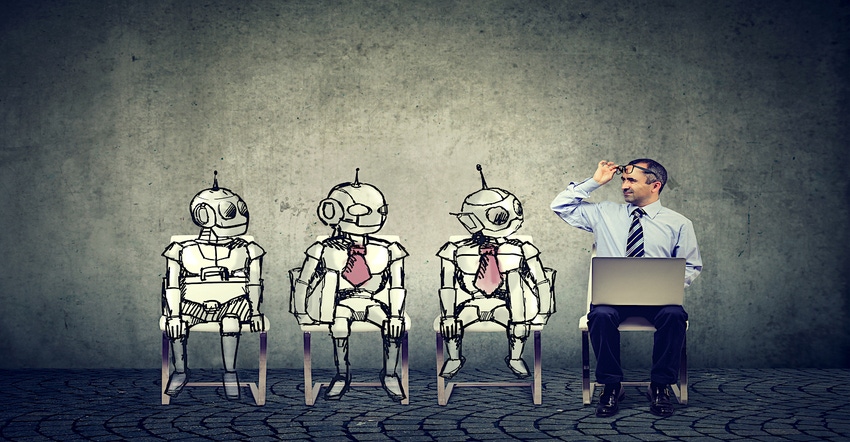AI-based technologies are making it difficult to distinguish humans from machines.
August 4, 2021

The much-heralded post-COVID year of 2021 is half over. The impact caused by the deadly global pandemic can now be seen in emerging tech trends, especially in AI. For example, consider these recent predictions from the Ericsson website.
The telecom giant blogged about the five top technology trends from 2021 that they believe are here to stay:
Trend 1 – Digital workplaces: By the end of June 2020, 42 percent of the U.S. labor force worked from home full-time. The market for collaboration software and video conferencing boomed.
Trend 2 – Online learning: Digital workspaces and dematerialization won’t just benefit those in the workforce. At the peak of the COVID pandemic, over 1.6 billion children in 195 countries around the globe were sent home as classrooms closed.
Trend 3 – Telehealth: The COVID-19 pandemic produced a considerable surge in telehealth technologies in the typically IT-resistant healthcare industry.
Trend 4 – Contactless convenience: Contactless technology defines the customer experience post-COVID, from touch-free payments and ‘just walk out’ shopping to biometric check-in for travel and accommodation.
Trend 5 - AI-generated content: Machine learning (ML) innovations like Generative Adversarial Networks (GANs) have gained momentum in recent years. These clever generative models use training data to ‘learn’ patterns to generate new data that resembles the original input. An example of the output is creating digital images that look like photos of real people, in the case of the rather unsettling website This Person Does Not Exist.

Of all these trends, the last one seems more than slightly disturbing. Should humanity be concerned?
Perhaps not. After all, looking human is one thing, but it’s the human capacity for creativity that sets us apart from AI-enabled machines. Right?
Recent developments have suggested that our most cherished difference from robots may not be entirely accurate. According to an op-ed piece in the Guardian, the Associated Press (AP) has been using AI to report on Minor League Baseball games for years. To prove the point, the Guardian published an op-ed article authored entirely by OpenAI’s language generator GPT-3.
The nascent technology proves to be so good that researchers at Penn State have admitted the famous Turing Test is no longer sufficient to tell a man from a machine. The Turing Test is used to determine the intelligence in a computer by requiring that a human being be unable to distinguish the machine from another human being by using replies to questions.
For example, Siri and other familiar voice-activated assistants would probably not pass the Turning Test. To pass, Siri would have to carry on a convincing conversation, including generating its thoughts and questions. For now, Siri can only construct simple sentences and short phrases.
But that is not the case with the OpenAI’s language generator GPT-3. Technology such as this generator is causing debate over whether humans or machines should write future content. The discussion is critical but may become less relevant as more AI-generated content continues to appear online. We just may not realize it.
Don’t Look into The Eyes!
Earlier this year, I wrote about how AI robots can manipulate human behavior. The friendly “Pepper” is a good example.
Several years ago – shortly after Softbank took control of Arm – the SoftBank Robotics America company created and deployed “Pepper.” This four-foot-tall robot came equipped with artificial intelligence and facial recognition software to understand human feelings and interact with passengers at airports. To convince humans that it understood their needs, Pepper used its built-in 20 plus motors and actuators to create meaningful gestures, move its head and arms, walk towards or away from people, shake their hands, and most importantly, take food orders and bring beers to customers.
Newer “care-bot” robots have one feature over the Pepper humanoid, namely, an anime-type face on the head display. This is important for one simple reason. This particular type of robot can easily manipulate human behavior. Studies have clearly shown that animated characters in movies emotionally sway humans. Disney animators, experts in the art of creating the illusion of life, have shown this to be true time and time again. Disney’s book reveals many of the tricks and techniques used to manipulate an animated image to create the illusion of life and the desired emotional reaction.
The responsibility for guiding the future behavior of robots (and humans) lies with all of us. Even ordinary people can shape the future through their economic choices as consumers, explained Keay. It’s certainly worth the effort to avoid the darkly comical “kill all humans” scenario from Futurama.
John Blyler is a Design News senior editor, covering the electronics and advanced manufacturing spaces. With a BS in Engineering Physics and an MS in Electrical Engineering, he has years of hardware-software-network systems experience as an editor and engineer within the advanced manufacturing, IoT and semiconductor industries. John has co-authored books related to system engineering and electronics for IEEE, Wiley, and Elsevier.
About the Author(s)
You May Also Like





